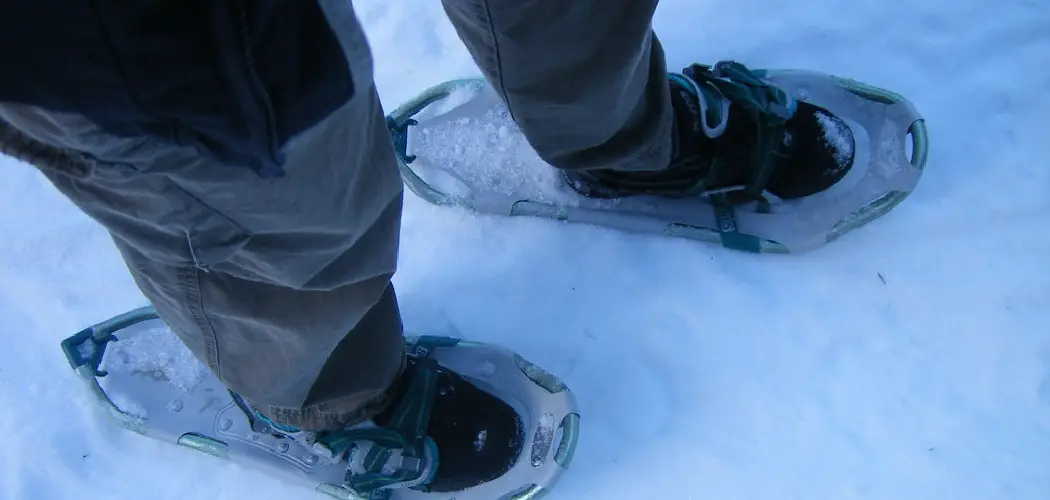Snowshoeing stands as an enchanting winter activity that beckons outdoor enthusiasts to step into a world transformed by snow. It’s an accessible sport that requires minimal equipment yet offers a profound connection with nature’s serene beauty during the colder months. In this comprehensive guide, we will explore the multitude of benefits that snowshoeing provides, from cardiovascular health advancements to mental well-being through the peaceful exploration of snow-blanketed landscapes.
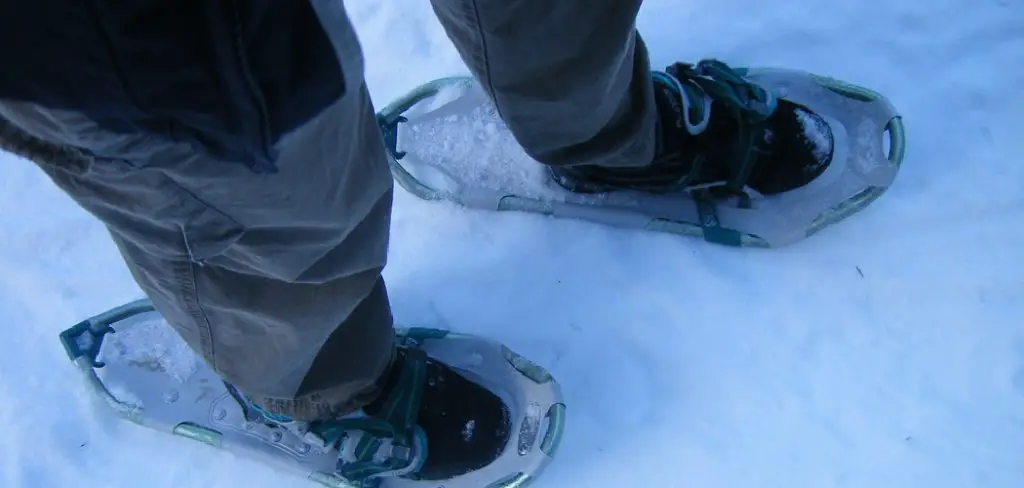
Our focus will be on how to walk in snowshoes effectively, ensuring beginners and novices alike can confidently traverse winter trails. By mastering the basics of snowshoeing, you’ll unlock the door to breathtaking vistas and the unique tranquility that can only be found in the heart of winter’s grip. Prepare to be immersed in the art of snowshoeing, where each step forward is a step into the majestic silence of the snow-covered wilderness.
Understanding Snowshoes
To excel in snowshoeing, it’s imperative to begin with a foundational understanding of snowshoes themselves. This knowledge enhances your experience and ensures safety and efficiency as you traverse the winter landscape.
A. Basic Anatomy
The anatomy of snowshoes is simple yet sophisticated, designed to maximize mobility across the snow. Each pair comprises four main components:
- Frame: Usually made of lightweight metal or composite materials, the frame outlines the shape of the snowshoe and supports the decking.
- Decking: Attached to the frame, the decking is typically crafted from synthetic materials. Its surface area distributes your weight over the snow, preventing you from sinking.
- Bindings: These secure your boots to the snowshoes. Bindings must be adjustable and comfortable yet firm to ensure your feet stay in place.
- Cleats (Crampons): Located on the underside of the snowshoes, cleats provide traction on snow and ice, crucial for uphill climbs and stability on varied terrain.
B. Functionality
The principal function of snowshoes is to distribute a person’s weight over a larger area. This process, known as flotation, is critical in preventing you from sinking deeply into the snow. By increasing the surface area in contact with the snow, snowshoes allow you to walk, hike, and even run on snow more efficiently than with standard footwear alone.
C. Choosing the Right Snowshoes
Selecting the appropriate snowshoes is vital for a fulfilling snowshoeing experience. Consider the following factors when making your choice:
- Terrain: Different designs cater to varying terrains, from flat and rolling to mountainous landscapes.
- Snow Conditions: Consider whether you’ll be exploring light, powdery snow or compact, icy conditions.
- Body Weight: Include the weight of any gear you’ll carry. Snowshoes are rated for specific weight ranges to provide optimal flotation.
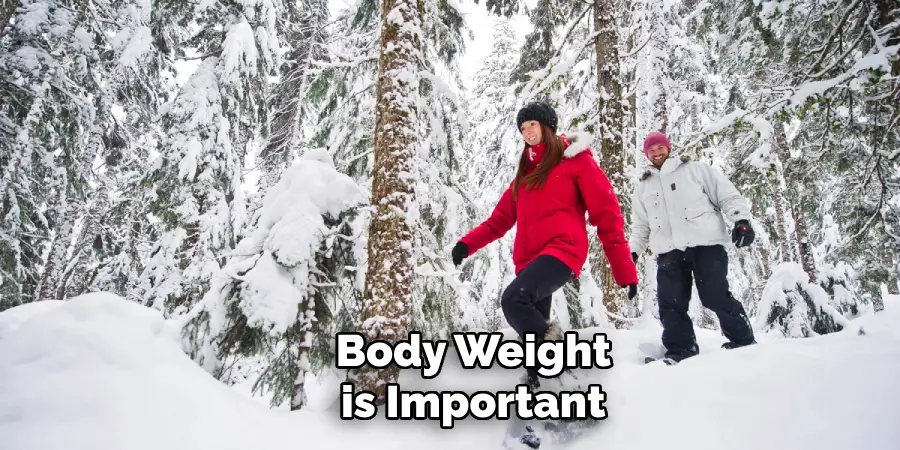
Understanding these aspects will guide you in choosing snowshoes that match your needs, ensuring a comfortable and enjoyable venture into the snowy outdoors.
Preparing for Your Snowshoe Adventure
Before venturing into a winter wonderland on snowshoes, proper preparation is key to ensuring a safe and enjoyable experience. This preparation involves careful attention to your attire, snowshoe adjustments, and optional equipment to enhance your adventure.
A. Dress Appropriately
The right clothing can differentiate between a comfortable excursion and a bitterly cold ordeal. Begin with insulating layers that can be easily added or removed as your body temperature changes. Synthetic or wool fabrics are preferable as they retain warmth even when wet and wick moisture away from the skin.
Over these layers, wear waterproof outerwear to shield against snow and wind. Don’t forget warm gloves and insulated, waterproof boots to keep your extremities from the cold. A beanie or hat that covers the ears will prevent significant heat loss from your head, an often-overlooked aspect of cold-weather dressing.
B. Adjust Snowshoes
Properly fitting snowshoes is fundamental to maneuvering through snow efficiently and safely. Begin by adjusting the bindings to fit your boots snugly, ensuring there is no slippage while walking. A secure and stable connection between your feet and the snowshoes will minimize the risk of blisters and improve your control over the terrain. It’s a good idea to practice adjusting these bindings at home to save time and avoid frustration in the cold.
C. Use Poles (Optional)
While not mandatory, trekking poles can significantly enhance your snowshoeing experience by providing added stability, especially in uneven terrain or whilst traversing slopes. Poles help distribute the effort between your arms and legs, reducing fatigue and improving balance. They can also be invaluable for testing snow depth and stability in uncertain areas. Choose adjustable poles to accommodate varying snow depths and personal height, and opt for models with large baskets to prevent them from sinking deeply into the snow.
Preparing thoroughly for your snowshoe adventure will ensure you stay comfortable, safe, and focused on the beauty and tranquility of your snowy surroundings.
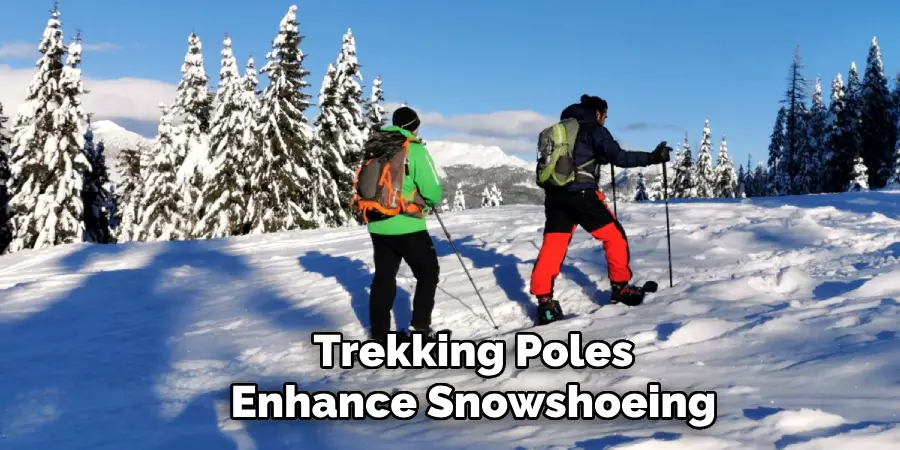
How to Walk in Snowshoes: Technique for Walking in Snowshoes
Walking in snowshoes involves a unique set of movements and balance compared to regular walking. Mastering the proper technique enhances your snowshoeing experience and minimizes the risk of injury. To ensure efficiency and safety on your snowy adventures, consider the following tips:
A. Wider Stance
Adopt a slightly wider stance than normal walking to accommodate the width of the snowshoes. This adjustment helps maintain balance and prevents the snowshoes from bumping into each other, which could cause tripping. The wider stance might feel unnatural at first, but with a little practice, it becomes second nature.
B. Lift and Plant
Lift your foot with each step and plant it firmly on the snow, allowing the cleats to grip and provide traction. This “lift and plant” method ensures that you fully use the snowshoes’ design, which facilitates movement across snowy terrains. It’s especially important in icy conditions or when ascending slopes where good traction is crucial.
C. Engage Core Muscles
Engage your core muscles for stability and balance, especially when walking uphill or across uneven terrain. Core engagement is vital as it supports your upper body and reduces the strain on your legs. This technique allows for a more efficient use of energy, which is particularly beneficial during long treks in the snow.
D. Avoid Dragging Feet
With each step, lift your feet clear of the snow to prevent dragging, which can lead to fatigue and tripping. Dragging your feet can also cause the snowshoes to accumulate snow, making them heavier and more difficult to manage. Remember, the aim is to glide over the snow rather than plow through it.
E. Take Shorter Steps
Take shorter, controlled steps to maintain balance and control, especially when negotiating steep inclines or descents. Short steps increase your stability by keeping your weight centered over the snowshoes. In steep terrain, it’s particularly helpful to lean slightly forward when ascending and to sit back into your hips when descending, using the shorter steps to keep control.
By incorporating these techniques into your snowshoeing, you’ll find that you can move more efficiently and safely through the winter landscape. Snowshoeing opens up a world of exploration and adventure in environments that might otherwise be inaccessible during winter. Practicing and refining your walking technique will ensure you get the most out of this rewarding winter activity.
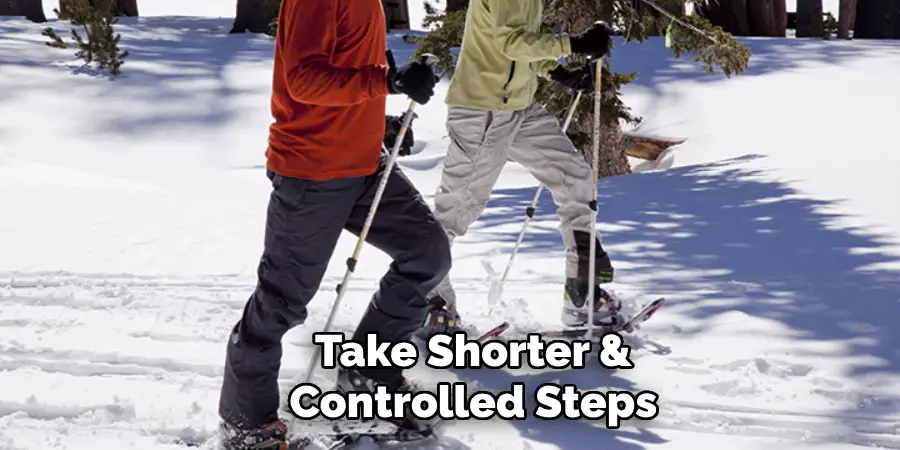
How to Walk in Snowshoes: Uphill and Downhill Techniques
Mastering the techniques for moving uphill and downhill in snowshoes can greatly enhance your efficiency and safety. Whether facing steep ascents or navigating slippery descents, the right approach will help you conserve energy and maintain control.
A. Uphill Ascents
Navigating uphill terrain in snowshoes requires a methodical approach. Lean slightly forward to distribute your weight over the front cleats of your snowshoes, maximizing their grip on the snow. Taking small, deliberate steps helps maintain stability and prevents you from overextending, which could lead to slipping or fatigue.
Trekking poles provide additional support, allowing you to engage your upper body and alleviate some of the strain on your legs. This forward lean and pole usage combination is key to efficient uphill snowshoeing, offering both traction and balance as you ascend.
B. Downhill Descents
Descending in snowshoes presents a different set of challenges, notably controlling your speed to prevent falls. Lean back slightly to shift your weight onto the heel cleats, which act as a braking system to control your descent speed. Adopt short, controlled steps to keep your balance and ensure your snowshoes maintain contact with the snow. This controlled approach reduces the risk of sliding uncontrollably or jarring impacts with the terrain. Poles again play a crucial role, providing an additional point of contact with the ground that can be used to steady yourself or adjust your speed as needed.
C. Traverse Across Slopes
Traversing across slopes in snowshoes involves a lateral movement that can be tricky to master. The key is to sidestep across the slope while keeping your body weight centered over your snowshoes to avoid slipping down. Use your poles for added stability and support, planting them in the snow uphill from your path to help balance your weight.
It’s also beneficial to angle your uphill snowshoe into the slope for better grip, ensuring each step is secure before moving the downhill snowshoe. This technique requires patience and practice but is essential for safely navigating across inclined terrains.
Adopting these specialized techniques for uphill and downhill movement and traversing slopes will significantly enhance your snowshoeing experience. By adjusting your body position and utilizing your equipment effectively, you’ll be well-equipped to confidently and easily tackle a wide range of snowy landscapes.
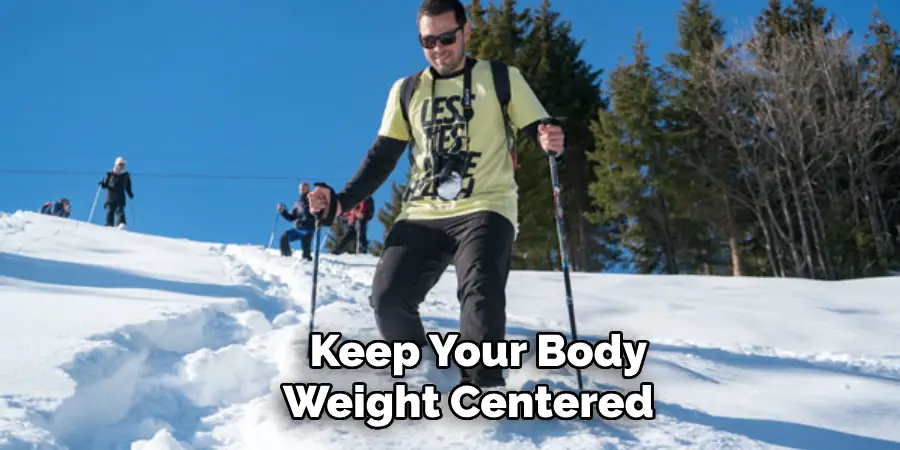
Safety Tips
Safety should always be a priority when snowshoeing, ensuring an enjoyable experience and minimizing the risks associated with winter outdoor activities. Here are essential safety tips every snowshoer should follow:
A. Stay Hydrated and Fueled
Despite the cold environment, your body loses fluids through sweat and breathing. It’s crucial to bring water and high-energy snacks to stay hydrated and nourished during your snowshoe adventure. Dehydration can lead to fatigue and hypothermia, so make regular stops to drink water and refuel your body with snacks like nuts, trail mix, or energy bars.
B. Be Aware of Avalanche Risk
Before heading out, check the avalanche conditions in your chosen area. Avoid high-risk areas, stick to designated trails, and avoid steep slopes. Knowledge of how to read the terrain and weather conditions for signs of avalanche risk is vital. If you plan to venture into areas where avalanches are a possibility, consider taking an avalanche safety course and carry appropriate avalanche safety gear such as a beacon, probe, and shovel.
C. Keep an Eye on the Weather
Weather in winter can change unexpectedly, bringing in sudden storms, reduced visibility, or extreme cold. Monitor weather forecasts and be prepared for changing conditions. Dress in layers to easily adjust your body temperature and carry emergency supplies, including extra food, water, and a basic first aid kit. Understanding and respecting the weather is key to a safe snowshoeing experience.
D. Know Your Limits
Snowshoeing can be physically demanding, especially in deep snow or challenging terrain. Start slowly and gradually increase the distance and difficulty of your outings. Listen to your body and be mindful of signs of fatigue or discomfort. Knowing when to take a break, rest, or even turn back is crucial to avoid exhaustion or injury. Snowshoeing should be enjoyable, not a test of endurance, so pace yourself and enjoy the winter scenery.
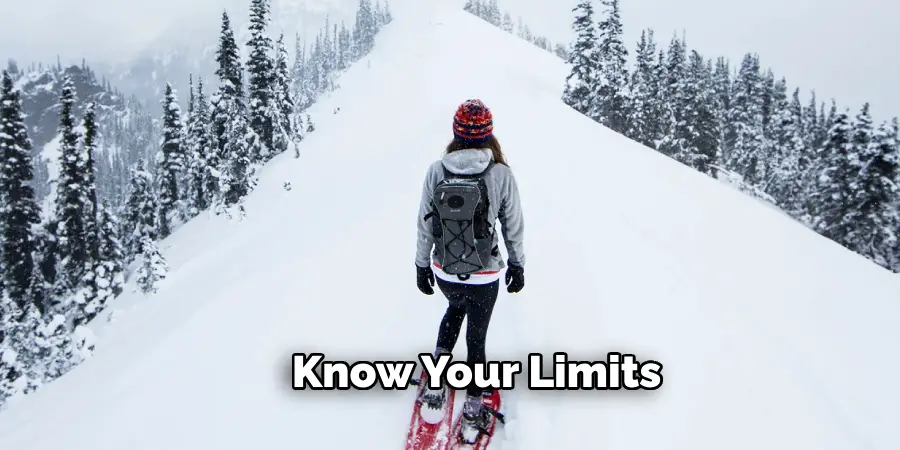
By adhering to these safety tips, snowshoers can enjoy the beauty and tranquility of snow-covered landscapes while minimizing the risks. Always plan ahead, equip yourself with the necessary gear and knowledge, and respect the power of nature to ensure a safe and memorable snowshoeing adventure.
Post-Snowshoe Care
Proper post-snowshoe care is crucial for maintaining the longevity and performance of your equipment. Here’s how to keep your gear in top condition:
A. Clean Equipment
After your snowshoeing adventure, it’s important to remove any snow and ice that has accumulated on your snowshoes and poles. Shake them gently or use a soft brush to remove the debris. Then, allow them to air dry completely before storing them. This step prevents the metal parts from rusting and keeps the fabric components from mildewing.
B. Inspect for Damage
Examine your snowshoes and equipment closely for any signs of damage or wear and tear, such as cracks in the frame, tears in the decking, or loose bindings. Addressing these issues promptly can prevent further damage and ensure your safety on future trips. If you’re unsure how to fix a problem, consult a professional for repair or replacement advice.
C. Store Properly
Store your snowshoes in a cool, dry place away from direct sunlight and moisture. Hanging them or placing them in a way that maintains their shape while not in use helps preserve their integrity and performance. Proper storage conditions prevent materials from degrading and prepare your snowshoes for your next winter exploration.
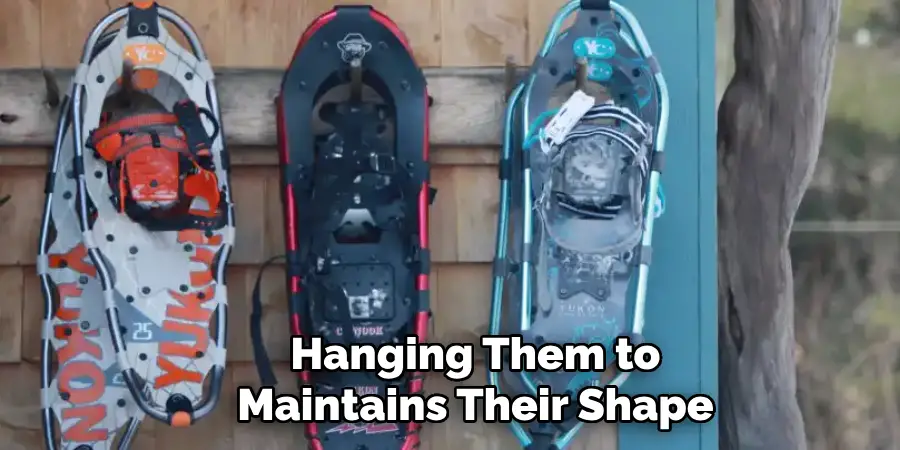
Frequently Asked Questions (FAQs) about Snowshoeing
Q1: Do I Need Any Special Skills to Go Snowshoeing?
A1: Snowshoeing is accessible to people of all skill levels, from beginners to advanced outdoor enthusiasts. No special skills are required to start, and it is an excellent way to enjoy the winter landscape. Basic walking skills and a sense of balance are enough to get you going, though navigating in deep snow or steep terrain may take a bit of practice.
Q2: What Kind of Gear Do I Need for Snowshoeing?
A2: The essential gear for snowshoeing includes a pair of snowshoes and adjustable poles with snow baskets. For clothing, it’s best to dress in layers to adjust to changing temperatures, including moisture-wicking base layers, insulation layers, and a waterproof outer layer. Also, waterproof boots, gloves, and a hat are important for keeping warm and dry.
Q3: Can I Snowshoe Anywhere that Has Snow?
A3: While snowshoeing can be done in many snowy areas, it’s best to stick to trails or areas designated for snowshoeing, especially for beginners. Some terrains may be dangerous or inaccessible due to deep snow, ice, or the risk of avalanches. Always check local regulations and trail conditions before heading out.
Q4: How Do I Choose the Right Size of Snowshoes?
A4: Snowshoe size is determined by your weight, including any gear you carry. Manufacturers provide weight ranges for each snowshoe model, helping you choose the right size for optimal floatation on snow. If you’re between sizes or plan to snowshoe in deep powder, it’s often recommended to go for the larger size.
Q5: Is Snowshoeing a Good Workout?
A5: Definitely! Snowshoeing is an excellent cardiovascular exercise that works your legs, core, and arms—especially when using poles. Due to the resistance of moving through snow and the additional weight of the snowshoes, it can burn more calories than walking at the same speed. It’s a great way to stay fit and explore nature during winter.
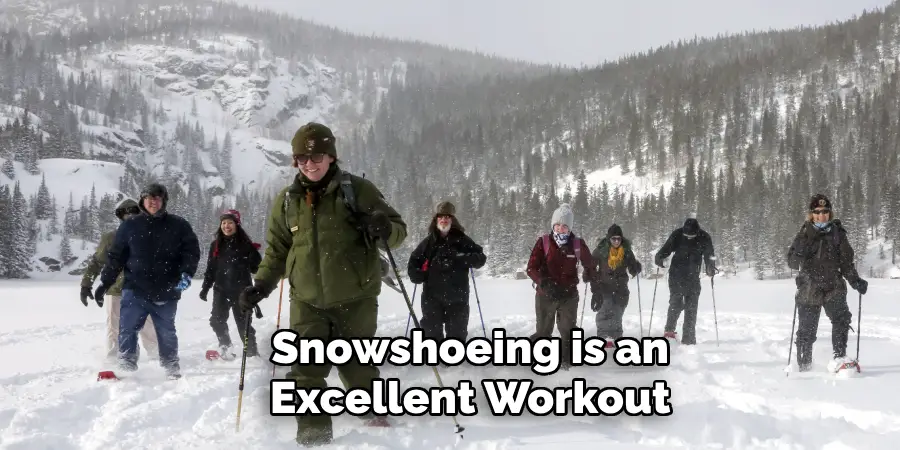
Conclusion
In this guide, we’ve covered essential snowshoeing techniques and safety tips, equipping you with the knowledge on how to walk in snowshoes with confidence and comfort. From mastering the basic movements to ensuring your safety in the unpredictable winter terrain, these insights aim to enhance your snowshoeing experience.
We encourage you to embrace the snowshoeing adventure, inviting family and friends to join you in exploring the breathtaking winter wonderland. Snowshoeing is more than just a winter activity; it’s a way to connect with nature, discover the serene beauty of snow-covered landscapes, and partake in a time-honored tradition. Whether you’re stepping onto the snow for the first time or seeking to refine your skills, the world of snowshoeing offers endless opportunities for exploration and enjoyment. Gear up, step out, and allow the silent whispers of the winter woods to guide your next snowshoeing adventure.

